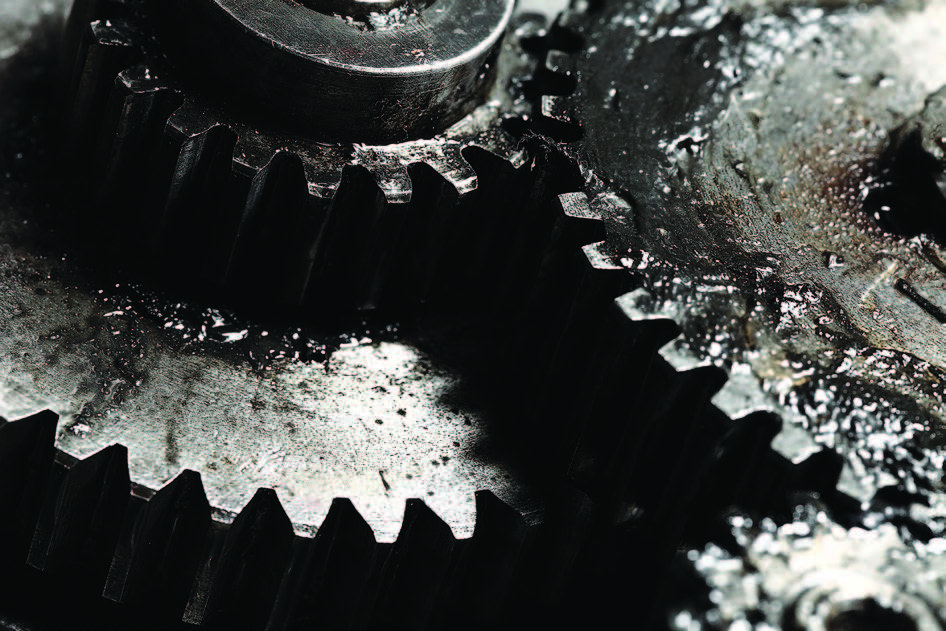Low coefficient of friction without formulated lubricants
Dr. Neil Canter, Contributing Editor | TLT Tech Beat January 2017
This is achieved through modification of a surface using a technique called shot peening.
KEY CONCEPTS
•
A process called shot peening can modify a cast iron block with a new surface that significantly lowers the coefficient of friction.
•
The surface finishing is best done with a combination of alumina and cuprous sulfide.
•
Spectroscopic analysis shows surfaces prepared with alumina and cuprous sulfide exhibit high wear resistance.
RESEARCHERS ARE STARTING TO DISCOVER THERE are alternative ways to produce low coefficients of friction when surfaces interact with each other without the use of formulated lubricants. Surface modification appears to be a key process in achieving this goal.
In a previous TLT article, surface modification is produced through the interaction of a lubricant base oil with a nanocoating containing a transition metal catalyst under severe operating conditions (
1). The resulting tribofilm contains amorphous carbon and demonstrates superior reductions in coefficient of friction and wear.
STLE-member Michael Varenberg, assistant professor in the George W. Woodruff School of Mechanical Engineering at Georgia Tech in Atlanta, says, “Lubricants have provided effective performance under a variety of operating conditions, but they do have limitations. For example, extreme pressure agents react with the surface to form stable films during use, but this process cannot be controlled and the resulting films are neither uniform nor optimized. Lubricant additives also can be expensive, and there can be environmental concerns when they are used.”
One alternative approach is mechano-chemical modification of a surface, which has a long history in tribology. Varenberg says, “My former supervisor studied the mechano-chemical form of abrasive wear in oil-lubricated roller bearings back in the 1970s. Looking at his results from a different perspective triggered my thinking on this topic.”
Varenberg hypothesized that use of a surface finishing process to activate a metal surface in combination with extreme pressure additives that will react with that surface might modify a surface to dramatically lower the coefficient of friction and reduce wear. He says, “Our strategy is to use existing mechanical processes that produce metal parts and to change the environment to include a tribologically beneficial chemical species that will take advantage of the activated surface to produce a layer of superior lubricity.”
SHOT PEENING
Varenberg and his colleagues modified a cast iron block of hardness 191 HV through a technique known as shot peening to produce a new surface that generated a significantly lower coefficient of friction. Shot peening is a cold working process that involves deforming the surface through impacts by moving particles.
Says Varenberg: “In our case, we discharged particles of alumina (aluminum oxide), cuprous sulfide and a combination of the two to shot peen the cast iron block. The particles were mixed with a stream of a nitrogen carrier gas held under a pressure of two bars to treat the surface for 30 seconds.”
The alumina particles ranged in size from 44-75 microns and exhibited a hardness of 2,600 HV. The cuprous sulfide particles were less than 44 microns in size and had hardness values less than 90 HV.
The researchers evaluated the modified cast iron block in a block-on-ring test. A mild steel ring with a hardness of 307 HV and a Group I solvent refined mineral oil were used in this evaluation. Coefficient of friction values were obtained under normal loads of 30 newtons and 50 newtons using various sliding speeds.
While a slight reduction in the coefficient of friction is seen in using alumina and cuprous sulfide separately, the most dramatic reduction is observed when both materials are used in peening the cast iron block. A tenfold reduction of the coefficient of friction to a value of 0.01 is found. Varenberg says, “This represents the lowest value ever reported in an application using a surface treatment such as shot peening and base mineral oil lubrication.”
The reason for the significant coefficient of friction reduction is that the surface is modified more effectively when alumina is used in combination with cuprous sulfide. Varenberg says, “Alumina surface peening led to surface hardening but did not have much other effect. Cuprous sulfide particles are smaller and softer that the cast iron surface and their impact only led to a smoother, less hardened surface. But using both materials together led initially to a mechanically activated surface that was better able to chemically interact with the cuprous sulfide creating a presumably more uniform and thicker sulfide surface film.”
X-ray photoelectron spectroscopy of the cast iron surface confirms that the combination of alumina and cuprous sulfide produces the highest concentration of sulfur on the surface.
When asked why the better known solid lubricants molybdenum sulfide and tungsten sulfide are not used, Varenberg believes that since copper is at a lower position in the electrochemical series than molybdenum or tungsten, this element is better able to be displaced from its sulfide by the more chemically active iron. In other words, the use of cuprous sulfide leads more readily to the formation of an iron sulfide layer on the iron surface.
Scanning electron microscopy of the cast iron surfaces also shows the surface treated with the combination of alumina and cuprous sulfide exhibits high wear resistance. Varenberg says, “We believe the modified layer is self-regenerating and does not easily wear away despite being thin. Under severe conditions, the sulfur present in the cast iron surface is believed to have an ability to migrate into the bulk of the material, thus maintaining the integrity of the sulfide film.”
With the hypothesis verified, Varenberg feels that a further understanding of physicochemical mechanisms of this surface treatment is needed. He says, “We also will be examining other surface finishing processes such as lapping and honing in conjunction with using other additives to determine how to tailor friction surfaces for specific applications (
see Figure 1).”
 Figure 1. A surface finishing process has now been developed that can facilitate a mechano-chemical modification of a surface to significantly reduce the coefficient of friction and lead to high wear resistance. Such a technique could lead to improved lubrication of gears. (Figure courtesy of Georgia Tech.)
Figure 1. A surface finishing process has now been developed that can facilitate a mechano-chemical modification of a surface to significantly reduce the coefficient of friction and lead to high wear resistance. Such a technique could lead to improved lubrication of gears. (Figure courtesy of Georgia Tech.)
Additional information on this research can be found in a recent article (
2) or by contacting Varenberg at
varenberg@gatech.edu.
REFERENCES
1.
Canter, N. (2016), “Tribocatalysis: A new extreme pressure lubrication approach,” TLT,
72 (10), pp. 10-11.
2.
Varenberg, M., Ryk, G., Yakhnis, A., Kligerman, Y., Kondekar, N. and McDowell, M. (2016), “Mechano-chemical surface modification with Cu2S: inducing superior lubricity,”
Tribology Letters,
64 (2), Article 28.
 Neil Canter heads his own consulting company, Chemical Solutions, in Willow Grove, Pa. Ideas for Tech Beat items can be sent to him at neilcanter@comcast.net
Neil Canter heads his own consulting company, Chemical Solutions, in Willow Grove, Pa. Ideas for Tech Beat items can be sent to him at neilcanter@comcast.net.